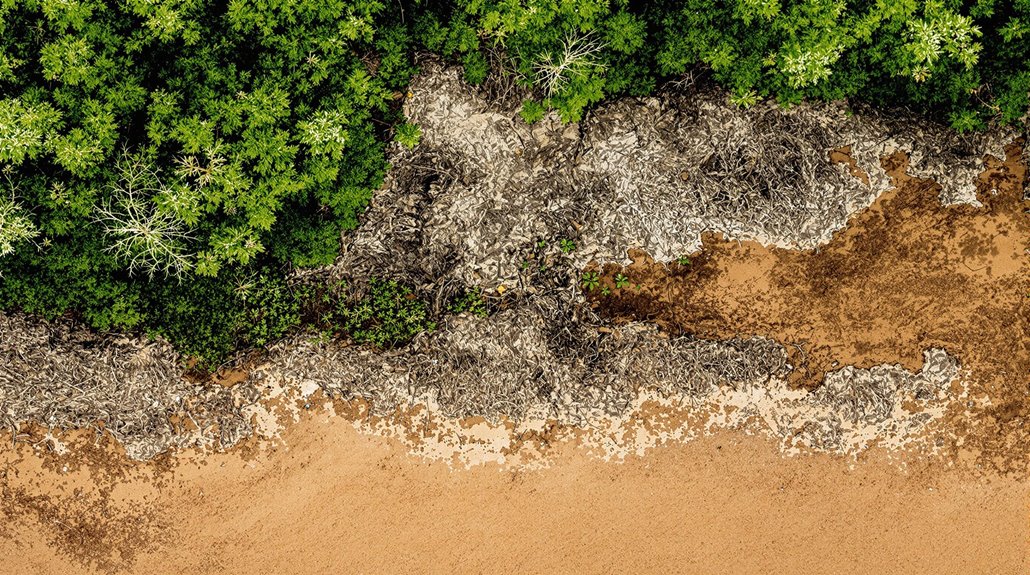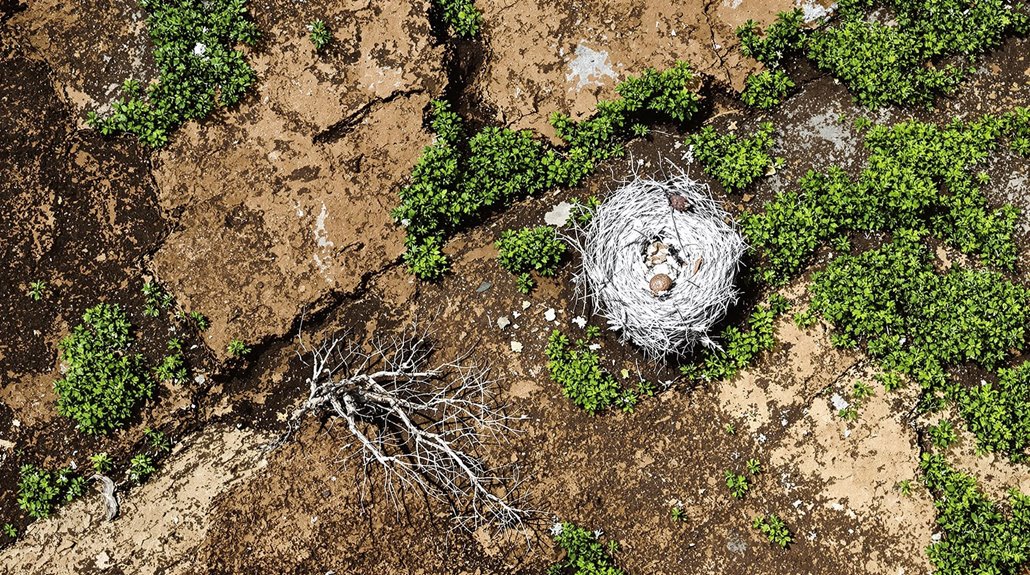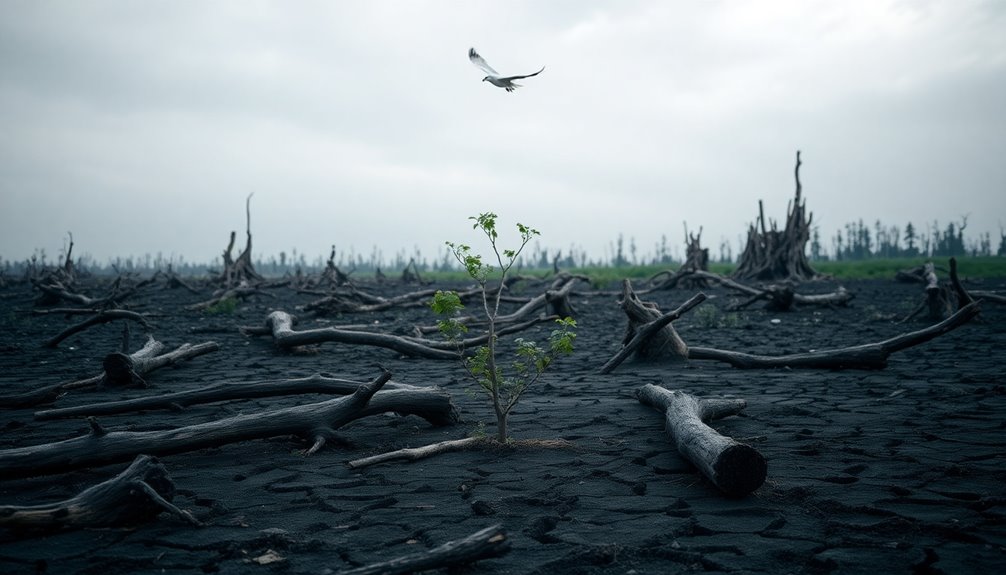Deforestation wreaks havoc on biodiversity by destroying habitats and isolating species. As forests are cleared for agriculture and logging, unique ecosystems vanish, threatening countless species with extinction. Fragmented landscapes allow invasive species to thrive, pushing native populations out and disrupting food chains. The removal of trees reduces the environment's ability to absorb carbon, exacerbating climate change. This cycle of destruction destabilizes ecosystems, leaving them vulnerable to environmental shifts. Ultimately, the loss of biodiversity impacts not just wildlife, but also human economies and well-being. Discovering the broader implications can highlight the urgency of conservation efforts.
Key Takeaways
- Deforestation drastically reduces biodiversity, risking extinction for numerous species and disrupting food chains critical for ecosystem stability.
- Fragmentation isolates species in smaller patches, decreasing genetic diversity and increasing vulnerability to extinction.
- Invasive species thrive in deforested areas, outcompeting native species and further diminishing biodiversity.
- The loss of forests reduces carbon storage capacity, exacerbating climate change, which negatively impacts ecosystems and biodiversity.
- Economic impacts from biodiversity loss include reduced agricultural productivity and challenges for tourism, highlighting the need for conservation.
Habitat Loss and Fragmentation

As natural habitats are transformed into urban areas or agricultural land, the consequences of habitat loss and fragmentation become increasingly evident.
You'll notice that conversion for human uses—like cropland, urban sprawl, and infrastructure development—destroys essential ecosystems. Deforestation, driven by agriculture and logging, further exacerbates this issue.
Urbanization and construction projects fragment habitats, isolating species in smaller, less sustainable patches. This isolation often leads to reduced species richness, as many plants and animals can't thrive in these fragmented areas.
Additionally, edge effects, such as increased sunlight and temperature changes, disrupt delicate ecosystems. The spread of invasive species also accelerates, threatening native populations and complicating conservation efforts. Climate change exacerbates the impacts of habitat loss, making it even more challenging for species to adapt and survive.
Addressing habitat loss is critical for maintaining biodiversity and ecosystem health.
Biodiversity Reduction

Deforestation greatly reduces biodiversity, leading to dire consequences for ecosystems and the species that inhabit them.
When habitats are destroyed, many species face extinction, unable to adapt to new environments. This loss disrupts food chains, as primary producers like trees are removed, leaving consumers without essential resources.
In addition, localized deforestation can wipe out unique species that thrive in small, isolated areas. The remaining animals often struggle against invasive species, which can outcompete and displace native populations. This is especially concerning as 10 million hectares of forest are lost annually, further exacerbating the crisis.
As a result, ecosystems become unstable and vulnerable to collapse. With species diversity dwindling, we're facing a global biodiversity crisis that threatens the balance of nature, making conservation efforts more important than ever.
Carbon Cycle Disruption

While you mightn't realize it, deforestation greatly disrupts the carbon cycle, leading to profound environmental consequences.
When trees are cut down or burned, the carbon stored in their biomass is released into the atmosphere as carbon dioxide. This contributes considerably to the greenhouse effect, exacerbating global warming and climate change.
In fact, the removal of tropical forests alone accounts for about six percent of global carbon dioxide emissions annually. Deforestation also reduces the number of trees available to absorb CO2 through photosynthesis, further increasing atmospheric carbon levels. Additionally, long-term carbon storage is compromised as forests diminish, further aggravating the imbalance in the carbon cycle.
As forests fragment and decrease, their ability to sequester carbon diminishes, creating a vicious cycle that intensifies climate change and alters essential climate patterns.
Forest Degradation

Forest degradation poses a serious threat to our planet's health, impacting not just wildlife but also human communities. Unsustainable and illegal logging, driven by the demand for cheap wood products, is a primary cause. Climate change exacerbates this, leading to more forest fires and pest outbreaks. Infrastructure development, like roads and dams, disrupts ecosystems and fragments habitats, while agricultural expansion and resource extraction worsen the issue. As forests degrade, they lose their ability to filter air and water, disrupting local water cycles and increasing fire vulnerability. This loss of biodiversity not only threatens unique species but also weakens the resilience of ecosystems. In fact, one-third of total forests lost since the end of the last ice age highlights the urgency of addressing deforestation. To combat this, we must prioritize sustainable practices and stronger regulations.
Indigenous Community Impact

As traditional guardians of the land, indigenous communities face profound challenges as their forests dwindle. You depend on these forests for food, medicine, and shelter, but deforestation is robbing you of your native land and disrupting your way of life.
With over 404 million hectares occupied in Latin America, the relentless advance of farming, logging, and mining threatens your homes. This loss also erodes your cultural identity, destroying sacred sites and disrupting the passing of traditions. Recent statistics indicate a 129% increase in deforestation within Brazilian Indigenous lands, exacerbating the already dire situation.
Health impacts are severe, as pollution and poverty lead to higher disease rates and malnutrition among children. Ultimately, as your traditional means of sustenance vanish, you may find yourself increasingly dependent on government assistance, further deepening social and economic inequality.
Global Consequences

The impact of deforestation extends far beyond the immediate loss of land for indigenous communities; it ripples across the globe, affecting biodiversity and ecosystem stability.
Tropical forests, housing 80% of the world's biodiversity, face severe threats as species like orangutans and tigers risk extinction due to habitat loss. Fragmentation isolates populations, reducing genetic diversity and weakening ecosystems.
Deforestation disrupts essential services like carbon sequestration and the water cycle, turning carbon sinks into emitters and decreasing rainfall. This leads to food insecurity, impacting both rural communities and wildlife. Additionally, the loss of biodiversity further exacerbates these challenges, making ecosystems more vulnerable to changes.
As ecosystems collapse, global climate patterns shift, resulting in rising temperatures and altered weather conditions. The consequences are profound, underscoring the urgent need for action.
Soil Erosion Effects

When deforestation occurs, it leads to significant soil erosion that threatens both ecosystems and human livelihoods.
Without trees to anchor the soil, you'll notice increased runoff and greater soil degradation. The uppermost layer can be easily swept away, reducing the land's nutrient cycling capability, which is essential for plant growth. Deforestation accelerates soil erosion as it removes vegetation that stabilizes soil, making it more susceptible to environmental elements.
As erosion rates accelerate, especially in rain-heavy regions, areas lose substantial topsoil, costing billions annually. This erosion harms infrastructure, undermines roads, and reduces hydroelectric productivity.
Additionally, sediment delivery into rivers raises beds, exacerbating flooding and harming aquatic life. In places like the Amazon Basin, soil erosion has surged over 600% since 1960, highlighting the urgent need for action to combat these devastating effects.
Invasive Species Threats

Deforestation not only accelerates soil erosion but also creates conditions ripe for invasive species to flourish. When trees and vegetation are cleared, it leaves an ecological void that invasive species enthusiastically fill.
With natural predators diminished or removed, these invaders thrive unchecked, rapidly spreading and outcompeting native plants and animals. Habitat fragmentation further exacerbates the issue, allowing invasive species to colonize isolated patches.
As they dominate, native species decline, leading to a loss of biodiversity. This has economic implications too, as invasive species can damage crops and forestry. Additionally, climate change can exacerbate the spread of invasive species by altering their habitats and giving them a competitive edge.
Diseases carried by these invaders pose risks to human health, highlighting the urgent need to address the threats posed by invasive species in the wake of deforestation.
Conservation Strategies and Solutions

While addressing deforestation's impact on biodiversity may seem intimidating, implementing effective conservation strategies can considerably reverse some of the damage.
Start with reforestation and afforestation, where you plant trees to restore deforested areas and create new ecosystems. Engage with local communities or support government initiatives for lasting effects. Reforestation and afforestation not only enhance biodiversity but also help in combating climate change by absorbing CO2 from the atmosphere.
Embrace sustainable forestry practices, like selective logging and reduced impact logging, to protect remaining habitats. Establish protected areas to safeguard wildlife, restricting harmful activities within these zones.
Advocate for international agreements like the Convention on Biological Diversity and support national policies focused on conservation.
Frequently Asked Questions
How Does Deforestation Affect Local Weather Patterns?
Deforestation greatly alters local weather patterns.
When you remove trees, evapotranspiration decreases, reducing moisture in the atmosphere. This disruption leads to less rainfall and can create a drier climate.
You might notice increased rainfall variability, resulting in unpredictable weather and intensified droughts.
As soil moisture declines, agricultural productivity suffers, impacting food security.
Understanding these changes helps you appreciate the vital role forests play in maintaining a stable and healthy climate for your community.
What Role Do Forests Play in Medicine and Pharmaceuticals?
You mightn't realize it, but the trees around you could hold the key to life-saving medicines.
Forests provide important resources for pharmaceuticals, with countless drugs derived from their plants. From the pain-relieving properties of willow bark to cancer treatments from the Pacific Yew, forests are fundamental in modern medicine.
As you explore these green spaces, remember that their preservation is essential for discovering future cures and maintaining health worldwide.
How Can Individuals Contribute to Forest Conservation Efforts?
You can contribute to forest conservation efforts in several impactful ways.
Start by reducing your paper consumption and choosing sustainably sourced products.
Participate in community tree planting events or support initiatives financially.
Educate others about conservation through conversations and social media.
Additionally, volunteer with local organizations or donate to reputable NGOs focused on preserving forests.
Every small action you take helps protect these essential ecosystems and promotes a healthier planet for future generations.
What Are the Economic Impacts of Deforestation on Local Communities?
Deforestation greatly impacts local communities' economies. You might notice that as forests disappear, livelihoods based on timber, food, and medicine vanish too. This loss can lead to unemployment and rising poverty rates.
Additionally, you could see food prices increase, making it harder to secure basic needs. The cultural significance of forests also diminishes, affecting community identity.
Shifting to sustainable practices can create new job opportunities, which helps rebuild local economies and support community well-being.
How Does Deforestation Influence Global Food Security?
Imagine a world where bare earth replaces lush forests, and hunger haunts communities.
Deforestation directly threatens global food security by degrading soil, disrupting water cycles, and causing biodiversity loss. Without trees, soil erodes and nutrients vanish, leading to diminished crop yields.
Unpredictable weather patterns create droughts and floods, impacting irrigation. As food supplies dwindle and prices soar, vulnerable regions face dire consequences.
It's a cycle that endangers both people and future generations.
Conclusion
In the words of the old adage, "You can't see the forest for the trees." Deforestation isn't just a loss of trees; it's a crisis that impacts every aspect of biodiversity and our planet's health. By recognizing the interconnectedness of ecosystems, you can appreciate the urgency of protecting these essential habitats. It's imperative that you support conservation efforts and sustainable practices to guarantee a thriving environment for future generations. Together, we can restore balance and protect our planet's rich biodiversity.









